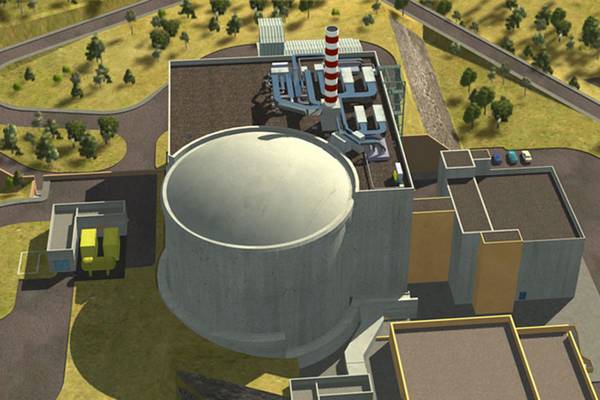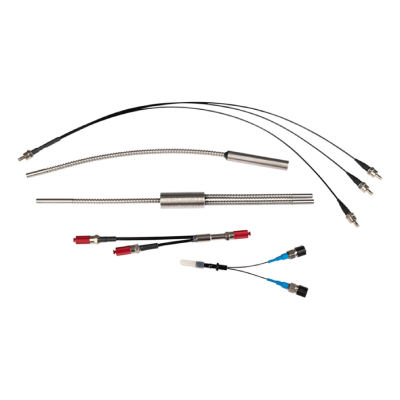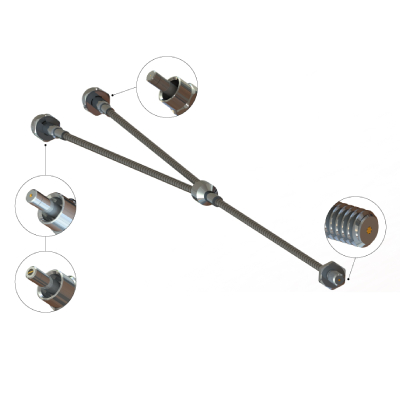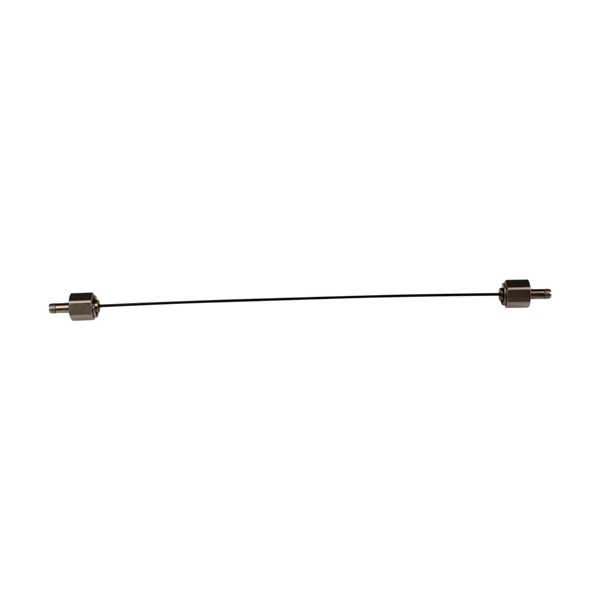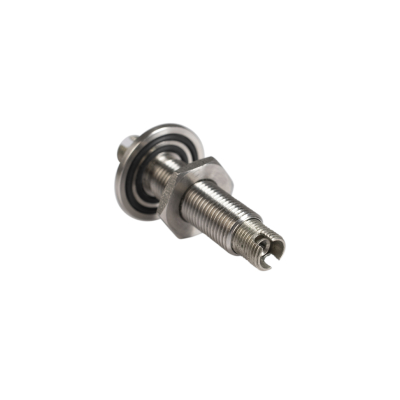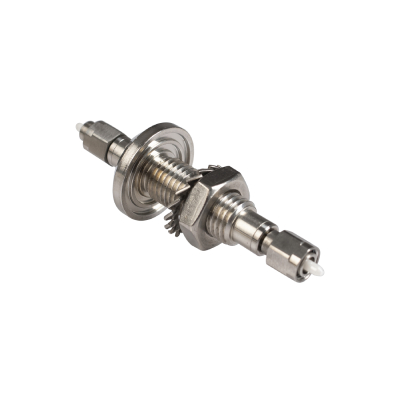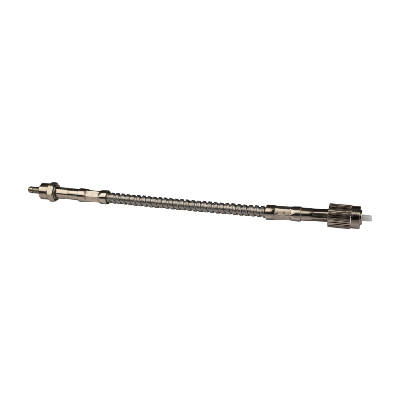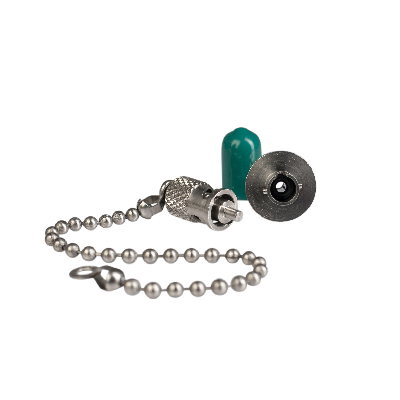ProbesFiber optic
Fiber-optic probes at the heart of the Jules Horowitz reactor
SEDI-ATI has designed custom-made fiber-optic probes to be placed at multiple locations inside the Jules Horowitz Reactor for safety imperative such as monitoring and securing the displacement of movable systems.
Majorconstraints
The probe must have a minimum lifespan of 10 years under the following conditions:
- Gamma irradiation; cumulative doses over 10 years: 1 GGy
- Immersion under a head of water of 11 m with temperature changes from +15 °C to +50 °C
- Thermal neutron flux: 2.6E+7 n/s/cm²
- Fast neutron flux: 7.3E+6 n/s/cm²
- Thermal neutron fluence: 5.7E+15 n/cm²
- Fast neutron fluence: 1.6E+15 n/cm²
- Hygrometry: < 85% at the poolside
The probe must also comply with the following mechanical strains:
- Non-presence of polymers inside the reactor
- Length of the probes inside the reactor: > 20 m
- Spatial resolution: < 0.3 mm
- The head of the probe must be extremely small
- Numerous tight bending radius of curvature induced by the pathway inside the reactor
Thechallenge
Introduce fiber-optic probes at the heart of nuclear reactors to secure the displacement of moving parts and prevent from a nuclear accident.
Fiber-optic assemblies securing the displacement of the MOLY devices
To ensure the safe displacement and accurate positioning of the MOLY devices, SEDI-ATI has been mandated to provide nuclearized fiber-optic probes. These probes, installed on the SAD, perform remote reflectivity measurements. They are aimed at measuring the accurate distance to the core of the reactor in order to prevent the SAD from striking the JHR core.
To withstand all the JHR safety and operational constraints, we have had to design an innovative fiber-optic probe with outstanding properties! Indeed, the probes are to be exposed to extreme irradiation conditions such as very intense neutron fluxes and gamma rays up to 1 giga Gray.
For this purpose, we have partnered with renowned manufacturers of optical fibers to co-develop two different preforms to draw unique optical fibers: a singlemode fiber and a multimode fiber. Both fibers are made of a pure silica core, a fluorosilica clad, a copper coating, and are threaded into a stainless steel tubing.
We have assembled more than 20 meters of 6 such multimode fibers around a central singlemode fiber to form the perfect fiber-optic probe. Because the probe is to be immersed under a head of water of 11 m, the head of the fiber-optic sensor is hermetically sealed in order to prevent from a capillary rise of water. There is no polymer material at all on the part placed inside the reactor. The probe is also equipped with a custom hermetic feedthrough to reach the control station.
About 90 of these fiber-optic probes will be placed at the heart of the Jules Horowitz nuclear reactor to monitor and secure the displacement and the positioning of the MOLY devices.
The importance of radioisotopes for public health
Among the radioisotopes that are important for public health, is the MOLybdène 99 (Mo-99). Indeed, by radioactive decay, this isotope is transformed into another isotope called Tc-99m, which is the most widely used tracer in nuclear medicine. 80 % of performed scintigraphy worldwide use this isotope, that represents approximately 30 million medical protocols per year, of which 8 million in Europe.
However, most of the reactors producing the Mo-99 are about to reach the end of their operational lifetime. That is the reason why the JHR project has been launched. JHR will assure the continuity of radioisotope production in the next decades. Operating 220 days per year, JHR will allow to produce between 25 % to 50 % of European needs, covering the treatment of 2 to 4 million of patients.
The MOLY and SAD devices installed on the floor of the reactor pool
Four devices, called MOLY (acronym for MOLYbdène 99), inside the reactor are aimed at producing this particular radioisotope Mo-99. They are installed on four movable systems, called equipment displacement apparatus (SAD), on the floor of the reactor pool.
They allow the radial displacement of the MOLY devices in order to achieve the loading and unloading of the various targets of a particular material or equipment to be tested. They also allow to move each target individually to a pre-defined position with a high degree of precision (adjustment pitch of 0,3 mm +/-0,1 mm) in order to accurately control and measure the level of irradiation incurred by the target.
For instance, it allows adjust the irradiation positions of the MOLY devices as a function of the reactor power (70 MW or 100 MW) in order to optimize the production of Mo-99.
An experimental pressurized water research reactor
The reactor will work as an International User Facility. It will serve purposes of a wide range of irradiation experiments in support to the nuclear industry, and for medical applications as well.
JHR will perform research and development programs that will serve the optimization of the safety and lifetime of present generation of Nuclear Power Plants (NPPs), assess innovations for next generation of NPPs, and offer irradiation experimental capacities to study material and fuel behavior under irradiation. The reactor will also be devoted to the production of medical radioisotopes.
Tests and qualification under 20 Ggy
The qualification has been done at the ISIS research reactor located on the CEA Saclay site in France, between June 2018 and July 2020. Both singlemode and multimode fibers have been exposed to irradiation conditions that far exceed the nominal conditions in a nuclear reactor.
The measured fiber attenuation at the end of the experiment in the SMF is 0.2 dB/km and is even less in MMF after exposition to 20 GGy!
SEDI-ATISolution
Through partnering, we have co-developed preforms to draw optical fibers (a singlemode and a multimode) to fulfill the customer’s requirements. Both fibers are made of a pure silica core, a fluorosilica clad, a copper coating, and an stainless steel tubing.
We have assembled 6 multimode fibers around a central singlemode fiber, to form a fiber-optic probe.
The head of the fiber-optic assembly is hermetically sealed in order to prevent from a capillary rise of water.
Advantagesof the SEDI-ATI solution
- Radiation hardness of fiber-optic assemblies and cables
- Immunity to electromagnetic effects
- Soldered assembly (no polymer)
- Smaller, more robust and more easily handled than a thermocouple
Related products
-
Fiber optic bundle assemblies for spectroscopy
Fiber-optic bundles are perfectly adapted to perform diffuse reflectance spectroscopic measurements.
-
Fiber optic bundle high-temperature reflection probe with screw cap
We offer bifurcated fiber-optic reflection probe bundles with a threaded tip for high-temperatures up to +400 °C.
-
High-temperature optical fiber patchcords
You are working at high-temperature levels? SEDI-ATI Fibre Optiques has the solution! Indeed, we have designed high-temperature cables for applications ranging from 150 °C to 1000 °C.
-
M10-thread fiber-optic feedthrough for vacuum and pressure up to 600 bar
The KTRAV-M10 reconfigurable hermetic fiber-optic feedthroughs are suitable for vacuum and pressure applications up to 600 bars. They ensure a high level of hermeticity better than 10-10 mbar.l/s.
-
M12-thread fiber-optic feedthrough for vacuum and pressure up to 1000 bars
The KTRAV-M12 hermetic fiber-optic feedthroughs are suitable for vacuum and pressure applications up to 1000 bars. They ensure a high level of hermeticity better than 10-9 mbar.l/s.
-
Radiation-resistant fiber optic cables
Optical fibers gather numerous advantages encouraging to integrate them in applications with radiative environments, associated with the civil, space or defense fields.
-
Threaded hermetic adapter up to 30 bars
The KTRAV-IP series is a hermetic adapter for pressure applications up to 30 bars.

